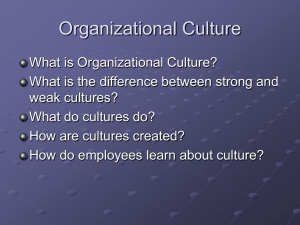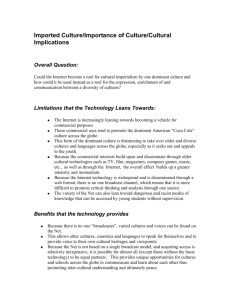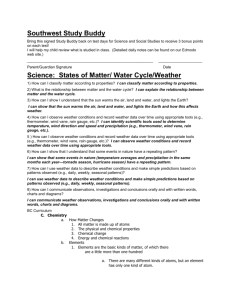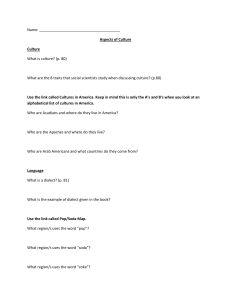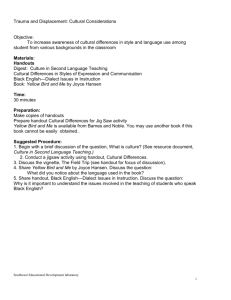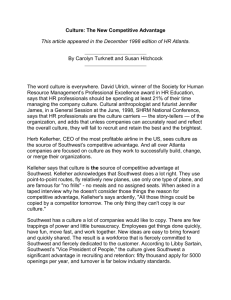Cultural Differences in Styles of Expression and
advertisement
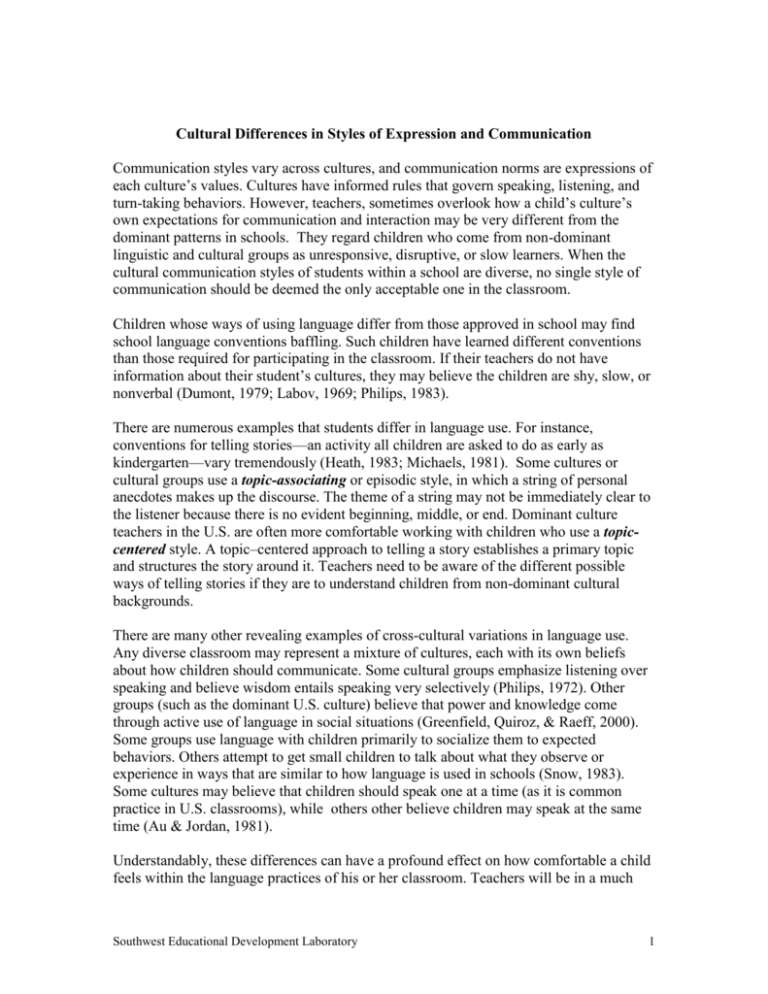
Cultural Differences in Styles of Expression and Communication Communication styles vary across cultures, and communication norms are expressions of each culture’s values. Cultures have informed rules that govern speaking, listening, and turn-taking behaviors. However, teachers, sometimes overlook how a child’s culture’s own expectations for communication and interaction may be very different from the dominant patterns in schools. They regard children who come from non-dominant linguistic and cultural groups as unresponsive, disruptive, or slow learners. When the cultural communication styles of students within a school are diverse, no single style of communication should be deemed the only acceptable one in the classroom. Children whose ways of using language differ from those approved in school may find school language conventions baffling. Such children have learned different conventions than those required for participating in the classroom. If their teachers do not have information about their student’s cultures, they may believe the children are shy, slow, or nonverbal (Dumont, 1979; Labov, 1969; Philips, 1983). There are numerous examples that students differ in language use. For instance, conventions for telling stories—an activity all children are asked to do as early as kindergarten—vary tremendously (Heath, 1983; Michaels, 1981). Some cultures or cultural groups use a topic-associating or episodic style, in which a string of personal anecdotes makes up the discourse. The theme of a string may not be immediately clear to the listener because there is no evident beginning, middle, or end. Dominant culture teachers in the U.S. are often more comfortable working with children who use a topiccentered style. A topic–centered approach to telling a story establishes a primary topic and structures the story around it. Teachers need to be aware of the different possible ways of telling stories if they are to understand children from non-dominant cultural backgrounds. There are many other revealing examples of cross-cultural variations in language use. Any diverse classroom may represent a mixture of cultures, each with its own beliefs about how children should communicate. Some cultural groups emphasize listening over speaking and believe wisdom entails speaking very selectively (Philips, 1972). Other groups (such as the dominant U.S. culture) believe that power and knowledge come through active use of language in social situations (Greenfield, Quiroz, & Raeff, 2000). Some groups use language with children primarily to socialize them to expected behaviors. Others attempt to get small children to talk about what they observe or experience in ways that are similar to how language is used in schools (Snow, 1983). Some cultures may believe that children should speak one at a time (as it is common practice in U.S. classrooms), while others other believe children may speak at the same time (Au & Jordan, 1981). Understandably, these differences can have a profound effect on how comfortable a child feels within the language practices of his or her classroom. Teachers will be in a much Southwest Educational Development Laboratory 1 better position to get children to participate in classroom talk if they understand how talk takes place in their student ’s homes. If children have not been expected to use language in “school” ways at home they will need time to learn those ways. Teaching new ways of using language need not result in a devaluation of children’s way with words. Southwest Educational Development Laboratory 2 VIGNETTE: The Field Trip Ms. Altchech's fourth-grade class was preparing to take a field trip to the Ballona Wetlands Park. They were lucky enough to have a wildlife docent from the park come to their classroom twice before the trip. When he asked the students what they knew about various animals they would likely see on the trip, they routinely answered with stories about animal experiences with their families. On the second visit, he let a couple of stories go by and then issued the admonition, "No more stories!" Ms. Altchech knew that what he wanted was a ''scientific discussion" with no "extraneous" commentary. She wasn't surprised, though, when his next question was met with silence. Why? Her students are largely from immigrant Latino families, and their cultures do not always stress the separation of content knowledge from social experience. Later, Ms. Altchech invited her students to tell their stories that related in some way to the planned field trip. As they talked, she constructed a T-chart on the board with key elements from the students' stories on the left. Then, she asked them to help her extract the ''scientific information" from their stories. For example, she used a student's comment that "the hummingbird's wing’s moved so fast” to draw information about the bird’s metabolism and feeding habits. The student participating, and the science lesson was taught in a culturally responsive way. Discussion The classroom extension below shows a reconstruction of the T -chart Ms. Altchech and her students developed. Through her instructional strategy, Ms. Altchech helped students move from a familiar discourse style to the more academic style expected in the classroom. She used their own strengths and values (including a strong orientation to family) to shape the instruction. She allowed students to relate their stories-stories that often involved trips or other family activities. The result was a high level of student engagement, ready identification of students' prior knowledge, and a joint construction of the "scientific knowledge" that was the goal of the lesson Classroom Extension STUDENT EXPERIENCE Carolina's Story SCIENTIFIC INFORMATION Hummingbird I was playing in the garden with grandmother and I saw a hummingbird near the cherry tree. Brownish with bright iridescent green and red coloring around head and neck Wings beat rapidly The bird “stood in the air.” I tried to go close to the pretty little bird, but it kept moving away. Southwest Educational Development Laboratory Has to eat frequently because it uses so much energy in its movements 3 Language—Dialect Issues in Instruction Possible Dialect Conflicts Possible Instructional Strategies Students omit final consonants or consonants in clusters. Draw attention to the contrast between student’s pronunciation and spelling and Standard English spelling. Generate a list of words with a similar pattern (e.g., cold, bold, mold, fold, hold). Note: This does not require correcting pronunciation but simply pointing out the differences and choices. Students use complex verb patterns that differ from what Standard English employs (e.g., “He be going…” t indicate a habitual behavior). Have the class or a small group brainstorm about alternative ways to get across the same meaning. (He often goes…, He usually goes…, He has a habit of going). Have students choose the best forms for their intended meanings. Discuss when Black English or standard English would be more appropriate or expressive. Students omit the copula (the verb “to be”) or the “s” possessive in places Standard English would use it. (e.g., “She thrilled about her brother good luck “ vs. “She is thrilled about her brother’s good luck.”) Again, help students make explicit the differences between the two dialects and make conscious choices about when to use either one. Students use Black Language style in a situation where Standard English would be more socially effective (e.g., writing a request for information to a public agency, preparing to give a pleas to the school board for additional resources for a special program). Use sociodrama to have students take on different roles, highlighting how one would communicate effectively in different situations. Sometimes Black Language will be more effective and sometimes Standard English will be; identify which applies where. Students use rhetorical features in writing that are considered “oral” strategies from the dominant dialect’s point of view (e.g., repetition of phrases or themes). Have students read their writing aloud and discuss whether or how this is effective to their purpose in writing. The student’s strategy could be powerfully effective depending on his or her intended use. Source: The Diversity Kit: An introductory Resource for Social Change Part III: Language. Lab at Brown. (2002)Web: www.lab.brown.edu Southwest Educational Development Laboratory 4

